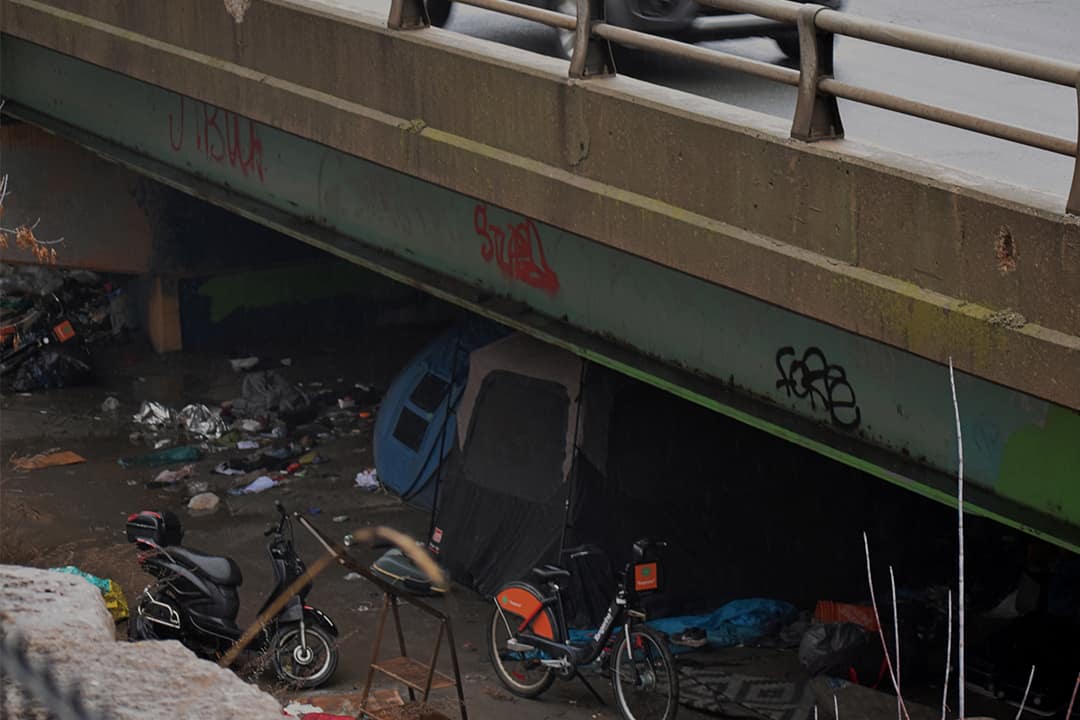Content warning: This article has mentions of death and substance use disorder.
On January 17, Alison Smith — a UTM political science assistant professor and the author of the upcoming book Filling the Gap: Cities and the Fight Against Homelessness in Canada — hosted a virtual webinar addressing the historical roots, current landscape, and future of Canada’s homelessness crisis.
In her talk, which has received 307 views on YouTube as of January 28, Smith noted how an unclear allocation of responsibility and inadequate resources have contributed to the issue.
The homelessness crisis
As of December 2023, York University’s research group the Homeless Hub estimated that between 150,000 and 300,000 people experience homelessness in Canada each year, although the high incidence of people experiencing hidden homelessness — in other words, people who find temporary housing and unstable housing situations, such as couch surfing — makes it hard to quantify. At least 35,000 people in Canada are experiencing homelessness on any given night.
HelpSeeker, a technology research company that focuses on social issues, applied an artificial intelligence model to data gathered by municipal governments on topics like shelter usage to estimate that the number of people experiencing homelessness will almost double by 2030. This estimate includes a large proportion of people who will experience hidden homelessness.
While the homelessness crisis has existed for decades, Smith explained that “over the course of the pandemic we saw it really reach new levels.” She noted that emergency shelters that enforced social distancing during the pandemic reduced their capacities, resulting in fewer people being able to access them. In addition, the opioid crisis that worsened during the pandemic resulted in the deaths of more than 2,790 people from April 2021 to March 2022 and disproportionately impacted people experiencing homelessness.
Smith said, “The continued existence of homelessness is certainly not free, it’s actually really expensive.” She explained that in 2021, the City of Toronto spent approximately two million dollars on clearing encampments. While she noted that encampments are not a long-term solution, many activists argue that dismantling encampments displaces people, leading to further housing insecurity.
Whose responsibility is it?
In the 1960s and 1970s — which Smith described as the “most successful era of Canadian housing policy” — the federal government invested highly in housing and partnered with provincial governments, co-ops, and nonprofits.
In the 1990s, the federal government dropped funding to develop affordable housing “down to zero” and changed the system of transferring funding to provinces, which “long story short, resulted in provinces getting a lot less money to implement their own social policies.” Most provinces cut their spending on social housing as a result.
In Ontario, former Premier Mike Harris implemented a realignment process that shifted responsibility for housing policy and funding to the local level. While responsibility has trickled down, Smith cited a lack of additional funding transferred to local governments to fulfill that responsibility.
“There’s a particular mismatch where we have the authority for housing at the local level, but the resources to be able to invest in an inclusive and sustainable housing system are at the provincial and federal level,” Smith said.
Additionally, much of Toronto has been zoned historically and contemporarily for single-family houses, increasing the difficulty of zoning for multi-family housing that could help increase housing affordability. The mismatched division of responsibility leads to an accountability issue in which the federal government points to local governments, and local governments point to provincial governments.
Alternative models
Smith noted that the protections for citizens’ rights in Canada’s constitution constitute ‘negative rights,’ “which [means] the government cannot interfere with your rights.” In practice, this means that while the government isn’t allowed to prevent access to resources — including housing — it is also not responsible for providing those resources to everyone.
In Wales, a country with positive rights, the government has a duty to assist people at risk of homelessness. This means that even before people begin to be at risk of homelessness, the government takes steps to secure housing for everyone. According to Smith, Wales’ emphasis on both universal prevention and clearly defined responsibility at the local level aids their approach.
Smith also pointed to BC Premier David Eby, whose policies — while they haven’t solved the homelessness crisis in BC — provide innovative solutions. Under Eby’s administration, the BC government has created the Rental Protection Fund — a housing group that helps purchase affordable rental buildings — which made $500 million in funding available for non-profits and other community groups to purchase properties, increasing the availability of quality social housing. Houses in this non-market sector are protected from rising costs, prioritizing affordability over profit.
Moving forward
Smith argues that the solution is “not easy to solve, [as] it requires a lot of collaboration.” Other experts echo this sentiment. Each solution is not only difficult to implement but will entail a trade-off of some kind.
According to Smith, a future without homelessness will not eradicate the demand for government-funded, owned, and operated social housing. She explains that “even if we were to move towards ending homelessness, there really always would be [a] need for [emergency shelters].”
“Federal, provincial, regional, municipal governments all have a role,” Smith explained. “It’s everyone’s responsibility, and so everyone needs to be bringing what they can, whether that’s resources or expertise or capacity or land.”


